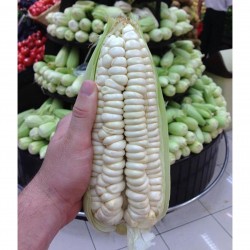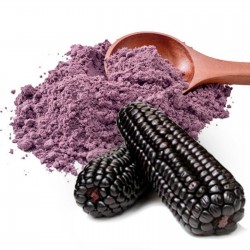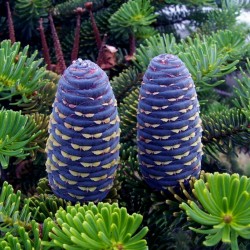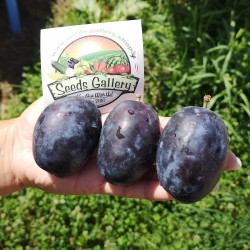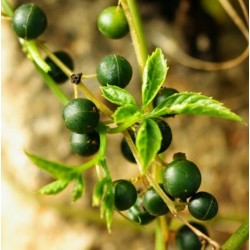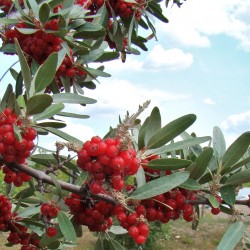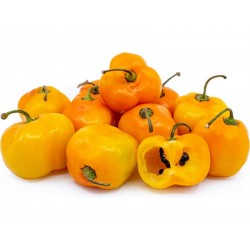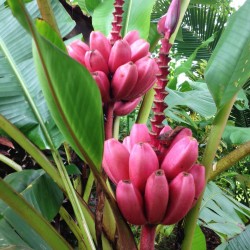Seeds Gallery Com,
5/
5
<!DOCTYPE html>
<html>
<head>
<meta http-equiv="Content-Type" content="text/html; charset=UTF-8" />
</head>
<body>
<h2><span><strong>Semințe de pin siberian (Pinus sibirica)</strong> </span></h2>
<h2><span style="color: #ff0000;"><strong>Preț pentru pachetul de 10 semințe.</strong> </span></h2>
<p>Nucile de pin sunt semințe comestibile de pin de cedru siberian (cedru siberian, Pinus sibirica) și alte pinuri de cedru care cresc în taiga întunecată de conifere din Siberia, Mongolia și nordul Chinei. De fapt, semințele acestor plante nu sunt nuci, dar acest nume este stabilit pentru ei în viața de zi cu zi, comerțul și gătitul.</p>
<p>Pinul de cedru din Siberia este un copac verde cu o înălțime cuprinsă între 18 și 40 de metri. Țesătura dreaptă a plantei este acoperită cu scoarță fisurată de nuanță cenușie-maronie. Arborele are o ramură înfășurată. Pe lăstari crește acele verzi moale închis, care este acoperit în continuare cu o floare albăstrui. Lungimea acului poate ajunge la 140 mm.</p>
<p>Pinul de cedru din Siberia este printre plantele dioice: pe fiecare copac găsiți conuri masculine și feminine. Polenizarea ovulelor care se află în axile cântarelor de acoperire a megastrobilului are loc cu ajutorul vântului. De obicei durează 14-15 luni pentru a se maturiza pe deplin. Consulurile de conuri cresc dimensiuni relativ mari (până la 130 mm în lungime și până la 80 mm în lățime), nuanțe violete sau maronie. Fiecare dintre ele conține între 25 și 150 de semințe de culoare maro închis (de până la 10 mm lățime și până la 14 mm lungime) de formă ovală sau ovoidă. Randamentul unui copac poate ajunge la 13 kg pe sezon.</p>
<p>Fiecare sămânță a cedrului de Siberian este un miez galben pal sau alb, acoperit cu cojile tari. Greutatea medie a unei nuci este 0, 24 g. Semințele de cedru siberian sunt consumate crude, folosite pentru a face ulei de cedru și făină, preparate cosmetice și medicina tradițională.</p>
<p>Atunci când cumpărăți fructe cu coajă lemnoasă în magazine și pe piețe, se recomandă să se acorde prioritate fructelor sau sâmburilor necurățate în ambalaje sub vid. Ar trebui să refuzați să cumpărați semințe care au un miros rânced, neplăcut, acoperit cu mucegai sau floare. Piulițele de pin trebuie depozitate într-un mediu răcoros, bine protejat de umiditate.</p>
<h2>Valoarea nutrițională a nuci de pin și vitamine în compoziția lor</h2>
<p><strong>Valoare nutrițională</strong><span> </span>de nuci de pin (100 g de parte comestibilă):</p>
<ul>
<li>13, 659 g de proteine;</li>
<li>67, 944 g de grăsime;</li>
<li>12, 989 g carbohidrați;</li>
<li>3, 671 grame de fibre dietetice insolubile;</li>
<li>2, 199 g de apă;</li>
<li>4, 887 g de acizi grași saturați;</li>
<li>1, 389 g amidon;</li>
<li>3, 584 g dizaharide, monozaharide.</li>
</ul>
<p><strong>Vitamine</strong><span> </span>în nuci de pin (la 100 g):</p>
<ul>
<li>0,984 μg echivalent de retinol (vitamina A);</li>
<li>0, 309 mg de acid pantotenic (vitamina B5);</li>
<li>4, 374 mg echivalent de niacin (vitamina PP);</li>
<li>0, 016 mg beta-caroten;</li>
<li>0, 359 mg de tiamină (vitamina B1);</li>
<li>9, 301 mg de echivalent tocoferol, alfa-tocoferol (vitamina E);</li>
<li>33, 961 μg de folat (vitamina B9);</li>
<li>54,006 mcg de filicinonă (vitamina K);</li>
<li>0, 218 mg de riboflavină (vitamina B2);</li>
<li>0, 793 mg de acid ascorbic (vitamina C);</li>
<li>0,091 mg de piridoxină (vitamina B6).</li>
</ul>
<h2>Valoarea energetică a nuci de pin</h2>
<ul>
<li>Conținutul caloric al nuci de pin (100 g) este de 672, 947 kcal.</li>
<li>Valoarea calorică a unei nuci de pin (cântărind 0,24 g) este de 1,615 kcal.</li>
<li>Valoarea energetică a bobului de cedru este de 431, 847 kcal.</li>
<li>Conținutul caloric al făinii de cedru este de 427,884 kcal.</li>
<li>Conținutul caloric al uleiului de cedru este de 897,667 kcal.</li>
</ul>
<h2>Elemente oligoelemente și macronutrienți în compoziția nuci de pin</h2>
<p><strong>Următoarele elemente</strong><span> </span>în 100 g de nuci de pin:</p>
<ul>
<li>5, 497 mg de fier;</li>
<li>0, 697 pg de seleniu;</li>
<li>8, 799 mg de mangan;</li>
<li>4, 274 mg zinc;</li>
<li>1322, 941 pg de cupru.</li>
</ul>
<p><strong>Macroelemente</strong><span> </span>în 100 g de nuci de pin:</p>
<ul>
<li>596, 718 mg de potasiu;</li>
<li>1, 914 mg de sodiu;</li>
<li>251, 009 mg de magneziu;</li>
<li>574, 816 mg fosfor;</li>
<li>17, 989 mg de calciu.</li>
</ul>
<h2>Proprietăți utile de nuci de pin</h2>
<ul>
<li>Nucile de pin sunt o sursă bogată de proteine vegetale: pentru a satisface aproximativ 15% din nevoia zilnică a organismului pentru acest nutrient, este suficient să consumați aproximativ 100 g de miez. În plus, proteina de semințe de pin siberian este caracterizată de un conținut ridicat de aminoacizi cu cea mai mică cantitate - metionină, lizină și triptofan.</li>
<li>Gruel de piulițe de pin cu plus de miere este ingerat cu bulbit, care a trecut în stadiul cronic de pancreatită, ulcer gastric, gastrită și alte boli inflamatorii ale tractului digestiv.</li>
<li>Nuci de pin - un remediu eficient pentru beriberi. În Kamchatka, kernelurile lor sunt folosite pentru prevenirea scorbutului.</li>
<li>Substanțele prezente în compoziția semințelor de pin siberian au proprietăți tonice și au un efect pozitiv asupra activității sistemului imunitar. Consumul regulat al acestora în alimente ajută la întărirea sistemului imunitar, la creșterea rezistenței organismului uman la infecții bacteriene, paraziți și viruși.</li>
<li>Compușii utili prezenți în compoziția nuci de pin, ajută la eliminarea colesterolului dăunător din organism și reduc riscul de ateroscleroză. În plus, au capacitatea de a regla tensiunea arterială, reducând simptomele neplăcute ale hipertensiunii.</li>
<li>Consumul regulat de nuci de pin contribuie la normalizarea nivelului de aciditate al sucului gastric și la combaterea patologiilor care apar în contextul creșterii acestuia. O mică mână de kerneli curățate vă permite să eliminați brusc arsul ars la stomac.</li>
<li>Tinctura alcoolică din semințele de cedru din Siberia este un mijloc eficace de combatere a manifestărilor de guta, reumatism articular, artrită și alte afecțiuni apărute pe fundalul metabolismului sarii afectat în organism. Pentru pregătirea sa, kernelul tăiat de nuci (uneori - împreună cu cochilie) sunt turnate într-un borcan de sticlă și umplut cu alcool. Amestecul este infuzat timp de 8 zile, filtrat și administrat oral de trei ori pe zi. O doză unică este de 12 ml.</li>
<li>Tortul, care rămâne după presarea uleiului de cedru, este un medicament valoroasă care ajută la normalizarea și îmbunătățirea metabolismului. Se adaugă la salate de fructe și legume, produse de cofetărie, muesli.</li>
<li>Consumul regulat de nuci de pin are un efect pozitiv asupra activității sistemului nervos central, contribuie la combaterea stărilor depresive și a nevrozelor și minimizează impactul situațiilor stresante asupra activității organismului. Pentru a obține un efect terapeutic, nucleele sunt administrate pe cale orală sau înfundate într-o ciupercă, iar pe baza lor se prepară o baie liniștitoare.</li>
<li>Nuci de pin au un efect benefic asupra muncii sistemului reproductiv masculin, stimulează activitatea glandelor sexuale și contribuie la creșterea potenței.</li>
<li>Consumul regulat de nuci de pin contribuie la creșterea rezistenței fizice.</li>
</ul>
<h2>Proprietăți utile de ulei de cedru</h2>
<ul>
<li>Uleiul de cedru este utilizat în mod activ în cosmetologie pentru fabricarea preparatelor pentru îngrijirea pielii. Tratamentele bazate pe acesta îmbunătățesc tenul, tonifică, înmoaie, întineresc, reîmprospătează și hidratează pielea, măresc elasticitatea și fermitatea și promovează exfolierea stratului superior al corneei. Siberian ulei de semințe de cedru este adesea folosit ca un remediu natural pentru a elimina cosmetice decorative și pentru a proteja pielea de la expunerea la radiații ultraviolete.</li>
<li>Mască pentru păr, pregătită pe bază de ulei de cedru, ajută la scăderea rapidă și eficientă a matreții. Împreună cu aceasta, hrănesc în mod activ părul, dau o strălucire frumoasă și sănătoasă, împiedică dezvoltarea alopeciei.</li>
<li>Uleiul de cedru ajută la scăderea roșeață, mâncărime, arsuri și umflarea alergiilor (zona afectată este ștersă cu un medicament).</li>
<li>Uleiul stoarse din nuci de cedru siberian este folosit ca un expectorant pentru raceli si boli ale tractului respirator superior.</li>
<li>Uleiul de pin nu diluează sângele, previne formarea cheagurilor de sânge, crește puterea și elasticitatea vaselor de sânge, reduce concentrația de colesterol din sânge și reduce semnificativ riscul de accident vascular cerebral, atac de cord, ateroscleroză, angină și alte patologii cardiace.</li>
<li>Uleiul de cedru este utilizat în mod activ în aromoterapie (inclusiv ca bază pentru alte uleiuri aromatice).</li>
<li>Uleiul stoarse din semințele de cedru din Siberia are proprietăți bactericide și de vindecare a rănilor. În medicina populară, este utilizat pentru tratamentul leziunilor cutanate cu boli dermatologice.</li>
<li>Uleiul de cedru se utilizează pentru a măcinat zonele afectate de artrită, reumatism articular, guta.</li>
<li>Consumul regulat de ulei stoarse din semințe de cedru de Siberian contribuie la reducerea influenței factorilor adversi asupra organismului uman care lucrează în producția periculoasă sau care trăiește într-o regiune cu o situație nefavorabilă de mediu.</li>
</ul>
<h2>Proprietățile utile ale coajă de nuci de pin</h2>
<ul>
<li>Coji de nuci de pin sunt utilizați în industria alcoolului pentru a face tincturi și balsamuri.</li>
<li>Infuzia preparată din cochilia de semințe de pin din Siberian are proprietăți antiinflamatorii, astringente și analgezice.</li>
<li>Vindecatorii folk susțin că utilizarea regulată a perfuziei de coajă de nucă de cedru din Siberia contribuie la creșterea acuității auditive.</li>
<li>Infuzia preparată pe bază de cedru de semințe de pin, are un efect pozitiv asupra funcției hepatice și a rinichilor. Pentru a obține rezultatul dorit, medicamentul este luat de 4 ori pe zi, o singură doză - 100 ml.</li>
<li>Un decoct bogat de coajă de nuci de pin de cedru este folosit extern ca mijloc de depilare.</li>
<li>Administrarea regulată a unei perfuzii preparate pe bază de coajă de nuci de pin contribuie la creșterea tonului general al corpului.</li>
<li>O infuzie bogată de cochilii de nuci de pin din Siberian este folosită ca remediu extern pentru frecarea cu dureri de corp, răceli, dureri reumatice și articulare și gută.</li>
<li>Infuzarea cochiliei de nuci de cedru siberian ajută la rezolvarea majorității încălcărilor din tractul digestiv. În medicina populară, este folosit ca un mijloc de combatere a indigestiei, diaree.</li>
<li>Un decoct bogat de coajă de nucă de cedru siberian are un efect benefic asupra funcționării sistemului sanguin. Persoanelor care suferă de afecțiuni ale sângelui se recomandă să bei zilnic între 1 și 1,5 cani.</li>
<li>Substanțele prezente în compoziția decoctului de cedru de nuci favorizează excreția toxinelor, otrăvurilor, excesului de colesterol, sărurilor.</li>
<li>Băile calde, bazate pe decoctul de coajă de nucă de cedru sibiric, ajută la atenuarea stării persoanelor care suferă de artrită, reumatism, lumbago și guta.</li>
<li>Loțiunile și compresele bazate pe decoctarea semințelor de coji de pin din Siberian contribuie la rezolvarea manifestărilor de lichen, eczeme, formațiuni pustuloase și alte boli dermatologice. În plus, instrumentul este utilizat pentru a accelera procesele de regenerare pentru arsuri.</li>
<li>Un decoct bogat al cochiliei de nuci de cedru siberian este folosit pentru a clăti gura în timpul stomatitei și a altor patologii dentare.</li>
<li>În cosmetologie, un decoct de coajă este folosit pentru vopsirea părului într-o culoare de castan moale.</li>
</ul>
<h2>Contraindicații și efecte nocive asupra nuci de pin</h2>
<ul>
<li>Nucile de pin sunt un alergen destul de frecvent. Abuzul acestui produs poate provoca o mare varietate de reacții alergice (până la șocul anafilactic). Din acest motiv, indivizii care au o tendință crescută de a dezvolta reacții de hipersensibilitate ar trebui să-și limiteze semnificativ consumul. Persoanele care au fost diagnosticate cu semințe de cedru siberian ar trebui să fie complet excluse din meniul lor.</li>
<li>Utilizarea nuci de pin rasina (rancid, sângeroase, afectate de microflora fungică) poate afecta capacitatea de a recunoaște senzațiile de gust. În acest caz, tulburările de gust pot persista câteva zile sau chiar săptămâni.</li>
<li>Nuci de pin - produs de calorii cu conținut ridicat de grăsimi. De aceea, persoanele care suferă de obezitate sau care doresc să piardă o anumită greutate ar trebui să-și limiteze semnificativ consumul.</li>
</ul>
</body>
</html>
T 26
